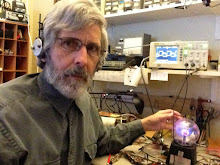Here I'm showing some results for shunt connected unknowns. BTW, in both cases the unknown is a series connected L-C circuit.
Recall that I discovered that my 1-ohm fixture had enough loop reactance (from inductance) to affect the measurement significantly, but in the series configuration it could be calibrated out. For the shunt case it wasn't so simple. So the "fixture" for shunt measurements needed to minimize the loop created by connection of the unknown. The simplest seemed to be just a BNC Tee with a BNC receptacle connected to the open end.
The two female ports go to the PHSNA DDS and the AD8307 measurement circuit.
I made some measurements with the type 2 and type 7 toroids again and with the molded choke, and I also added a couple of air wound B&W type coils - one small and one quite a bit larger. In all cases I selected resonating silver mica capacitors to give resonance around 7.5 to 8.5 MHz. Just for consistency and to be somewhat "midband HF". I also added series resistances in several instances, to see if my measured Rx would increase by the amount I added, as a method of checking accuracy.
BTW, there are no transformers or minimum loss pads here, so this is a 50 ohm environment.
Below are some results from my spreadsheet.
If the data table doesn't fit the column, click it to make it full size.
I feel like I'm getting pretty decent results here, consistent with my expectations.
BTW, elsewhere in my spreadsheet I enter my dBm measurement with the unknown port open and again with the unknown network connected to give me the attenuation caused by the unknown. I also enter the environment resistance (50 ohms), and it gives me Rx, the series resistance of the network, presumed to belong mainly to the inductor.
I also enter the measured inductance of the coil and the resonant frequency and my spreadsheet gives me the Q of the circuit.
NRK 4/8/2015



No comments:
Post a Comment